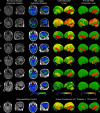[18F]AV-1451 binding in vivo mirrors the expected distribution of TDP-43 pathology in the semantic variant of primary progressive aphasia
- PMID: 28912300
- PMCID: PMC6166613
- DOI: 10.1136/jnnp-2017-316402
[18F]AV-1451 binding in vivo mirrors the expected distribution of TDP-43 pathology in the semantic variant of primary progressive aphasia
Abstract
Introduction: Semantic dementia, including the semantic variant of primary progressive aphasia (svPPA), is strongly associated with TAR-DNA binding protein 43 (TDP-43) type C pathology. It provides a useful model in which to test the specificity of in vivo binding of the putative tau ligand [18F]AV-1451, which is elevated in frontotemporal lobar degeneration tauopathies.
Methods and results: Seven patients (five with svPPA and two with 'right' semantic dementia) and 12 healthy controls underwent positron emission tomography brain imaging with [18F]AV-1451. Two independent preprocessing methods were used. For both methods, all patients had clearly elevated binding potential (BPND (non-displaceable binding potential)) in temporal lobes, lateralising according to their clinical syndrome and evident in raw images. Region of interest analyses confirmed that BPND was significantly increased in temporal regions, insula and fusiform gyrus, consistent with those areas known to be most affected in semantic dementia. Hierarchical cluster analysis, based on the distribution of [18F]AV-1451 binding potential, separated semantic dementia from controls with 86% sensitivity and 100% specificity.
Conclusions: [18F]AV-1451 binds in vivo regions that are likely to contain TDP-43 and not significant tau pathology. While this suggests a non-tau target for [18F]AV-1451, the pathological regions in semantic dementia do not normally contain significant levels of recently proposed 'off target' binding sites for [18F]AV-1451, such as neuronal monoamine oxidase or neuromelanin. Postmortem and longitudinal data will be useful to assess the utility of [18F]AV-1451 to differentiate and track different types of frontotemporal lobar degeneration.
© Article author(s) (or their employer(s) unless otherwise stated in the text of the article) 2018. All rights reserved. No commercial use is permitted unless otherwise expressly granted.
Conflict of interest statement
Competing interests: None declared.
Figures


References
Publication types
MeSH terms
Substances
Grants and funding
LinkOut - more resources
Full Text Sources
Other Literature Sources
